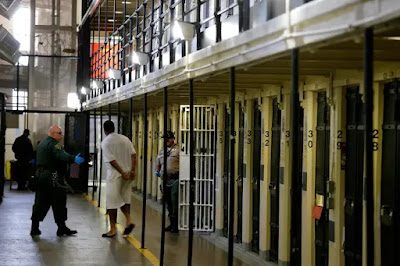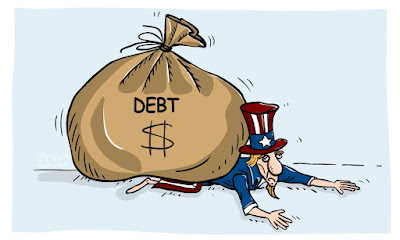Written by Steve Rhode
Originally published at Get Out of Debt Guy
When
it comes to a rapidly accelerating financial burden on American families, there
is no greater concern than student loans.
The
debt is burdensome and unfair on many levels that I’ll explore below.
However,
there is a straightforward and simple solution for dealing with all of this
outside of struggling to develop a fair forgiveness strategy. I’ll talk about
that after we look at common opinions on the subject.
Is Student Loan Forgiveness Fair?
The talk of
forgiveness is a difficult topic because how do you reach any level of
fairness.
And
let me be clear when people talk about forgiving student loans, it only applies
to federal student loans. Not private student loans.
As
Howard Dvorkin, Chairman of Debt.com said,
“Only one-third of the people in this country get a four-year college
education. The two-thirds without a college education is expected to subsidize
their education when it is very likely that they earn less than the people who
are receiving the educational subsidy.”
Dvorkin went on to
say, “The issue of forgiving debt is complicated. What about all the people
that have already struggled to pay their debts, and now other people get loans
forgiven. That’s not fair.”
Student Loans – Another Financial Mistake for Many
A 2019 student by New
York Life of 2,200 adults found the average participant reported taking 18.5 years to
pay off their student loans, starting at age 26 and ending at 45.
That
is a significant portion of life to have to be tied to a student loan payment
that should have been directed to saving for retirement and then mushroomed
into a giant nest egg. It can take decades to recover from that financial
mistake. But that’s not the only financial regret people have.
What
is shocking is the number of people that have student loan debt but who never
graduated. I’ve seen statics as high as 75 percent of people with any student
loans never obtained the degree.
And
the wave of for-profit schools that have oversold education to people that
never should have purchased their product is another national disaster.
“For-profit
schools are not worth the money,” said Dvorkin. “As an employer, I hire people
with traditional non-profit college degrees before I would hire someone with a
for-profit degree.”
The
Federal Reserve Bank of New York said, “Students who attend for-profit
institutions take on more educational debt and are more likely to default on
their student loans than those attending similarly selective public schools.”
The
study went on to say, “Overall, our results indicate that, on average,
for-profit enrollment leads to worse student loan outcomes for students than
enrolling in a public college or university, which is driven by higher loan
takeup and worse labor market outcomes. This is an important set of findings
for several reasons. First, a substantial amount of public funds go to
for-profit institutions through the financial aid system. Our estimates
indicate the return to such expenditures may be quite low. Second, the results
suggest that students who attend local for-profit institutions when there is a
negative labor demand shock may be making mistakes: they would be better off
attending the local public college or university instead.”
But
even non-profit schools are ramping up tuition and selling students into seats
that maybe should not have been admitted.
Student loan debt is
a life sentence in painful debt for many: The Impossibility of Forgiveness
Opinions on forgiveness range all over
the place. Betsy DeVos, the current Secretary of Education said
recently,
“Policies should never entice students into greater debt. Nor should they put
taxpayer dollars at greater risk. There are too many politicians today who
support policy that does both.”
She
also labeled student loan forgiveness as an “insidious notion of government
gift giving. We’ve heard shrill calls to “cancel,” to “forgive,” to “make it
all free.” Any innocuous label out there can’t obfuscate what it really is:
wrong.”
Forgiveness
is never going to be fair, and it’s not going to a quick and effective way to
stimulate the economy in a difficult time from a pandemic, as some claim.
Today,
student loan forgiveness would result in people not making loans they are
already in default on or making payments that are too low to pay the debt off.
At most, it will result in people not having to make some loan payments
monthly.
The
economic impact will be felt over a long period of time rather than the boost
and support the economy needs now.
While
DeVos talks about avoiding policies that entice students into greater debt, her
own Department of Education is a big part of the problem, with help from
Congress.
As
the federal student loan program stands now, there is $1.37 trillion of
outstanding debt to students, and the Education Department has determined that
borrowers will only pay back $935 billion. That leaves the program in the red
and holding for $435 billion of bad loans.
The Wall
Street Journal said,
“The analysis was based on government accounting standards and didn’t include
roughly $150 billion in loans originated by private lenders and backed by the
government.”
To
deal with that shortage, “Congress will have to raise taxes, cut services or
increase the deficit to cover the losses.” That solution is also not fair to
the many that repaid their loans.
So the Battles and Arguments About Student Loan
Forgiveness Are Complicated
We
can argue and politically position ourselves around the idea of forgiving
student loans is either the best thing or the worst thing ever to happen.
It
is actually a moot point since the program is in so much trouble already.
Let’s not forget the 42
million student loan borrowers will become due again in January
2020, as a result of the CARES Act forbearance ending.
People
that can’t afford their student loans will suddenly be required to begin
payments again. Defaults will explode even more.
As it stands now, the Department of
Education’s base position is students should feel lucky they can enroll student
loan debt in an Income-Driven Repayment program (IDR)
that will give them a loan payment based on income. But, as I wrote
before, it’s
a trap.
As
it stands now, while a student loan debtor might enroll in an income-based
repayment program, the minimum payment is not enough to cover the interest
being charged on the loan, and the balance owed grows. While people say,
“certainly Congress will change that.” The reality is they have not, over the
many years the programs have been in place.
So
the way the “lowest payment” solution works right now is that the government
lets you pay less than is due, that grows the balance, and in two decades, when
the exploded balance is forgiven, people will owe income tax on that debt
unless they are insolvent. It sounds crazy, but it is true.
Here is
a case that is a great example of the madness. The student loan debtor could not
afford to pay off her $40,000 of student loans over 14 years but is now
required to enroll and remain in an IDR that will drive her balance up.
The
article by Richard Fossey J.D. says, “How could the judge conclude
that Hladly might someday pay off her student loans when the amount she
initially borrowed had tripled since the time she graduated from law school? If
Hlady could not pay off $40,000 in student loans over 14 years, how will she
ever pay $140,000 over the next 25 years, especially since her loan balance
grows by $20 a day in accruing interest?
As
Judge Scarcella observed, Ms. Hlady is 48 years old. Her 25-year repayment plan
will terminate when she is 73. By that time, her loan balance will be more than
a quarter of a million dollars. This amount will be forgiven, but the forgiven
debt will be taxed as income unless Hlady is insolvent at the time.”
With IDR Plans, the Government Has Already Accepted
the Loan Forgiveness Proposition
In my opinion, with federal student loan forgiveness programs already on the
books, policymakers have already accepted some form of loan forgiveness. Yet,
the current talk of student loan forgiveness ranges from its “socialism” to its
“a right.”
As
it stands today, the federal government already runs a student loan program
that is rapidly increasing in delinquencies, defaults, and repayment plans that
will only grow the balance.
The
only current winners in the student loan cycle are the schools that can sell
students on attending and get easy money from the federal government.
Students
enroll, schools get paid and accept almost no responsibility for the outcome.
When a student loan debtor was sold education, they could never logically or
mathematically afford and later defaults; the school does not have to pay back
the loan.
Howard
Dvorkin said, “Colleges must start operating as a business and deliver service
within income. The days of college expansion paid for from easy government
student loan money needs to stop.”
He’s
right.
Student Loan Forgiveness is Much-Ado-About-Nothing and
Misdirected
I
hate to state the obvious here, but rather than worry about the inequities of forgiveness
and who wins and loses, the most rational and logical option is to roll back
the 2005 Bankruptcy Abuse Prevention and Consumer Protection Act (BAPCPA).
BAPCPA
made private student loans harder to discharge in bankruptcy. And private
student loans are growing as well.
The
issue is students are drowning in debt. It can be argued that because of
student loan debt, they are also having to take out other debt and reduce
retirement savings.
When
those people are old enough and can no longer work, the lack of retirement
savings will create a public safety net drain. No matter how you look at this,
the systemic problem of easy money for education has driven up the debt, and we
will all pay for it in one way or another.
The Solution Seems So Apparent
Up
until 1976, all student loans were dischargeable in bankruptcy. Bankruptcy is a
legal right for consumers to get a fresh financial start, and it is even a part
of the U.S. Constitution. Those that file for bankruptcy generate an immediate
stimulus for the economy and have a second chance to do better, having learned
hard lessons from mistakes.
Returning
to allowing both federal and private student loans to be discharged in
bankruptcy has many features:
1.
It
is a current and accepted legal process with clear rules and guidelines.
2.
The
debt is forgiven tax-free.
3.
It
allows people a chance to get a fresh start from an impossible situation.
Oftentimes these issues are the result of accidents, injuries, medical issues,
pandemics, etc.
4.
A
bankruptcy Trustee and Judge must review and approve the discharge plan. If a
consumer has too much income for a full immediate discharge, they will be
required to enter a five-year repayment plan in a Chapter 13 bankruptcy.
5.
Forgiveness
will be restricted to only those that qualify.
6.
The
fact the loans may now be dischargeable should force lenders to make better
loan decisions before just handing the money to anybody.
7.
If
loans are less abundant or actually just based on repayment ability, then
schools would have to ratchet back tuition fees. Less easy money would be
available.
8.
This
process would be restricted to those who need and meet the accepted legal
standards for bankruptcy.
9.
People
that can afford to repay their loans will have to do so through their Chapter
13 repayment plan.
10. We can eliminate this
ridiculous game and administration of student loans that will never be repaid
and have to be dealt with.
If We Restore Bankruptcy Student Loan Debt Elimination
to All Then We Can Focus on Doing Better
There
is no argument that education leads to opportunity. I don’t care if that is
education at a trade school, some other hands-on education, or a degree in some
college subject at the best school in a 200-mile radius.
I
heard recently about a “toilet paper” degree program. That’s where plumbers
make much more than people to go to college. I do know some very rich
electricians and plumbers. I guess that’s a raw subject for me since I’ve spent
$3,000 in plumbing bills in the last 30 days.
We
have a wonderful system in place to allow people to have affordable access to
start their education. The local community college is a fantastic place to
start.
It
is affordable, and as Dvorkin said, “When thinking of how to get started on the
journey of education, community college is a great investment. Think about
this: why pay much higher tuition to take classes that use the same books as
the community college class uses. Start affordably and then transfer to a more
expensive school if you want to continue to finish your college degree.”
The
power of community colleges is not new. It is proven. My very own father
started his education from a farm in Michigan at the local community college.
He then went on to become the very first Ph.D. graduate in Political Science at
Michigan State.
So
let’s all stop trying to reinvent the wheel here. Just restore the bankruptcy
provision for all student loans and require some commonsense and responsibility
on future lending.
There
will never be any universally accepted plan for past forgiveness of student loans
that were flawed from the start.
We
are a great country and instead of looking back, let’s do better moving
forward.








